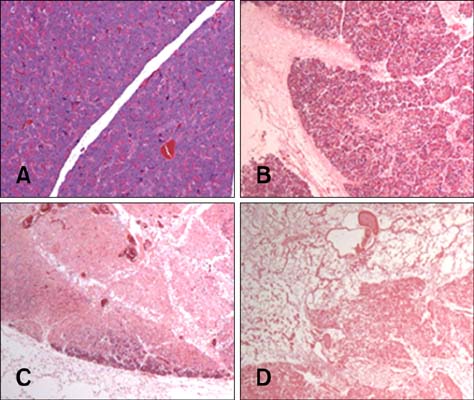J Vet Sci.
2014 Dec;15(4):551-556. 10.4142/jvs.2014.15.4.551.
Use of laparoscopy for diagnosing experimentally induced acute pancreatitis in dogs
- Affiliations
-
- 1Haemaru Referral Animal Hospital, Seongnam 463-050, Korea.
- 2Department of Veterinary Internal Medicine, College of Veterinary Medicine, Seoul National University, Seoul 151-742, Korea. hyyoun@snu.ac.kr
- 3Department of Veterinary Medical Imaging, College of Veterinary Medicine, Chonnam National University, Gwangju 500-757, Korea.
- 4Department of Veterinary Pathology, College of Veterinary Medicine, Seoul National University, Seoul 151-742, Korea.
- KMID: 2070242
- DOI: http://doi.org/10.4142/jvs.2014.15.4.551
Abstract
- Diagnosis of acute pancreatitis in dogs remains a significant challenge despite the development of advanced diagnostic methodologies. Visual inspection and pancreas biopsy using laparoscopy are generally considered to be procedures free of complications when conducted on healthy animals. However, the usefulness of laparoscopy for diagnosing acute pancreatitis has not been assessed. In the present study, the efficacy of laparoscopy for diagnosing acute pancreatitis in dogs was evaluated in animals with experimentally induced acute pancreatitis. Gross appearance of the pancreatic area was examined by laparoscopy to survey for the presence of edema, adhesions, effusion, pseudocysts, hemorrhage, and fat necrosis. Laparoscopic biopsy was performed and the histopathologic results were compared to those of pancreatic samples obtained during necropsy. The correlation between laparoscopy and histopathologic findings of the pancreas was evaluated. The presence of adhesions, effusion, and hemorrhage in the pancreatic area observed by laparoscopy significantly correlated with the histopathologic results (p < 0.05). There was no significant relationship between the histopathologic and laparoscopic biopsy findings. Results of this study suggested that laparoscopic evaluation of gross lesions has clinical significance although the laparoscopic biopsy technique has some limitations. This method combined with additional diagnostic tools can be effective for diagnosing acute pancreatitis in dogs.
Keyword
MeSH Terms
Figure
Reference
-
1. Bradley EL 3rd. A clinically based classification system for acute pancreatitis. Summary of the International Symposium on Acute Pancreatitis, Atlanta, Ga, September 11 through 13, 1992. Arch Surg. 1993; 128:586–590.
Article2. Cosford KL, Shmon CL, Myers SL, Taylor SM, Carr AP, Steiner JM, Suchodolski JS, Mantovani F. Prospective evaluation of laparoscopic pancreatic biopsies in 11 healthy cats. J Vet Intern Med. 2010; 24:104–113.
Article3. Dugernier T, Laterre PF, Reynaert MS. Ascites fluid in severe acute pancreatitis: from pathophysiology to therapy. Acta Gastroenterol Belg. 2000; 63:264–268.4. Harmoinen J, Saari S, Rinkinen M, Westermarck E. Evaluation of pancreatic forceps biopsy by laparoscopy in healthy beagles. Vet Ther. 2002; 3:31–36.5. Isaji S, Hayashi J, Higashiguchi T, Yokoi H, Ogura Y, Noguchi T, Kawarada Y. Effect of IS-741(a new synthetic anti-inflammatory agent) on acute necrotizing pancreatitis in dogs. Significance of its inhibitory effect on cytosolic phospholipase A2. Digestion. 1999; 60:suppl 1. 47–51.
Article6. Ishida H, Furukawa Y, Kuroda H, Kobayashi M, Tsuneoka K. Laparoscopic observations and biopsy of the pancrease. Endoscopy. 1981; 13:68–73.
Article7. Magne ML, Tams TR. Laparoscopy: instrumentations and technique. In : Tams TR, editor. Small Animal Endoscopy. 2nd ed. St. Louis: Mosby;1999. p. 397–408.8. Newman S, Steiner J, Woosley K, Barton L, Ruaux C, Williams D. Localization of pancreatic inflammation and necrosis in dogs. J Vet Intern Med. 2004; 18:488–493.
Article9. Robertson E, Webb C, Twedt D. Diagnostic laparoscopy in the cat: 2. Common procedures. J Feline Med Surg. 2014; 16:18–26.10. Sakorafas GH, Tsiotou AG. Etiology and pathogenesis of acute pancreatitis: current concepts. J Clin Gastroenterol. 2000; 30:343–356.11. Saunders HM, VanWinkle TJ, Drobatz K, Kimmel SE, Washabau RJ. Ultrasonographic finding in cats with clinical, gross pathologic, and histologic evidence of acute pancreatic necrosis: 20 cases (1994-2001). J Am Vet Med Assoc. 2002; 221:1724–1730.
Article12. Senninger N, Moody FG, Coelho JC, Van Buren DH. The role of biliary obstruction in the pathogenesis of acute pancreatitis in the opossum. Surgery. 1986; 99:688–693.13. Stweart AF. Pancreatitis in dogs and cats: cause, pathogenesis, diagnosis and treatment. Comp Cont Educ Vet Pract. 1994; 16:1423–1430.14. Twedt DC. Laparoscopy of the liver and pancreas. In : Tams TR, editor. Small Animal Endoscopy. 2nd ed. St Louis: Mosby;1999. p. 409–419.15. Twedt DC, Monnet E. Laparoscopy: technique and clinical experience. In : McCarthy TC, editor. Veterinary Endoscopy for the Small Animal Practitioner. 1st ed. St. Louis: Elsevier Saunders;2005. p. 357–385.16. VanEnkevort BA, O'Brien RT, Young KM. Pancreatic pseudocysts in 4 dogs and 2 cats: ultrasonographic and clinicopathologic findings. J Vet Intern Med. 1999; 13:309–313.
Article17. Washabau RJ. Feline acute pancreatitis-important species differences. J Feline Med Surg. 2001; 3:95–98.
Article18. Webb CB, Trott C. Laparoscopic diagnosis of pancreatic disease in dogs and cats. J Vet Intern Med. 2008; 22:1263–1266.
Article19. Williams DA, Steiner JM. Canine exocrine pancreatic disease. In : Ettinger SJ, Feldman EC, editors. Textbook of Veterinary Internal Medicine. 6th ed. St. Louis: Elsevier Saunders;2005. p. 1482–1488.
- Full Text Links
- Actions
-
Cited
- CITED
-
- Close
- Share
- Similar articles
-
- Correlating two-dimensional shear wave elastography of acute pancreatitis with Spec cPL in dogs
- Clinical Approach for Patients with Hypertriglyceridemia-Induced Acute Pancreatitis
- Effects of Extracorporeal Shock Wave Lithortripsy Experimentally Induced Cholelithiasis and Organs in the Dog
- A Case of Acute Pancreatitis Induced by Multiple Drugs in a Patient with Ulcerative Colitis
- Effects of allopurinol on experimentally induced pancreatitis of rats




